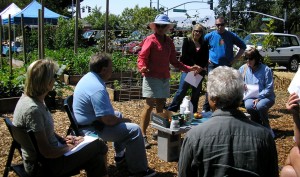
Maile speaking with some examples of fertilizer options on the table. As usual she was filled with infectious enthusiasm.
Maile’s tomato talk captivated a small but attentive crowd at our first zazu farmstand market. Here is the text of her talk:
GROWING TOMATOES by Maile Arnold
Types of tomatoes: Determinate and Indeterminate Determinate varieties of tomatoes, also called “bush” tomatoes, are varieties that are bred to grow to a compact height (approx. 4 feet). They stop growing when fruit sets on the terminal or top bud, ripen all their crop at or near the same time (usually over a 2 week period), and then die. They may require a limited amount of caging and/or staking for support, should NOT be pruned or “suckered” as it severely reduces the crop, and will perform relatively well in a container (minimum size of 5-6 gallon). Examples are: Rutgers, Roma, Celebrity (called a semi-determinate by some), and Marglobe. Indeterminate varieties of tomatoes are also called “vining” tomatoes. They will grow and produce fruit until killed by frost and can reach heights of up to 10 feet although 6 feet is considered the norm. They will bloom, set new fruit and ripen fruit all at the same time throughout the growing season. They require substantial caging and/or staking for support and pruning and the removal of suckers is practiced by many but is not mandatory. Examples are: Big Boy, Beef Master, most “cherry” types, Early Girl, most heirloom varieties, etc.
Heirloom and Hybrid: Heirloom tomatoes come true from seed while hybrids do not. Tomatoes are tropical plants and do not like cold nights. They will be stressed and thus more susceptible to disease. My rule of thumb is after Mother’s Day. I only grow indeterminate tomatoes and like to train them on 4” hog wire so they are very two dimensional. Most of the suckers are removed so that there are 4 main canes with short side shoots. The leaves receive maximum sun and air circulation thus reducing disease. The fruit is easy to pick.The alternative is to cage the plants.Starting seeds: I start seeds that I have saved from the earliest and best tomatoes from the year before. I plant them in flats and transplant to deep paper cups (Vente latte cups) that have holes punched in the bottom. I put the seedling low in the cup and backfill with potting soil as the plant grows. The stem will sprout roots and the plant will have a healthy root system. The cup is easily labeled. When planting, I tear off the bottom and pull apart the side seam and leave the cup close by for ID. I like to start seeds by April 1st. After planting, the plants can be covered with Frostguard Row Cover or surrounded by 1 gallon jugs filled with water for protection from the cool nights.
Saving seeds: I smear the seeds on newspaper so that there is only 1 layer, label and allow to dry. The following year the paper can be torn and planted (think seed tape)
Dealing with the bounty: I blend the tomatoes and cook them to reduce by ½ then can or freeze the sauce. To dry, remove a strip of skin and then slice. Put them on racks in the back of the car, crack the windows and park in the sun. Remove when leathery and seal tightly.
Sources for seed: Superseeds.com, Internet
Sources for plants: Harmony Farm Supply, Oldies and Goodies (sold at Bassignani and Andy’s)
Leave a Reply
You must be logged in to post a comment.